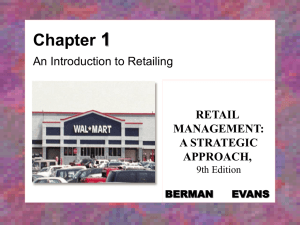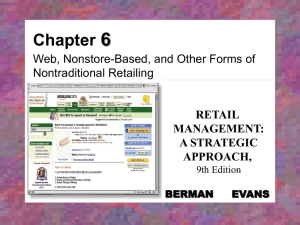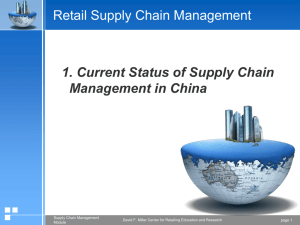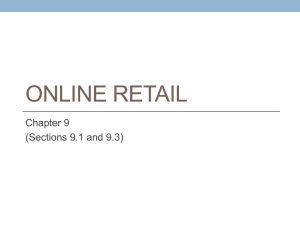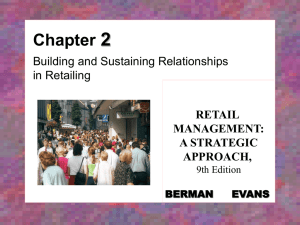Chapter 1
advertisement
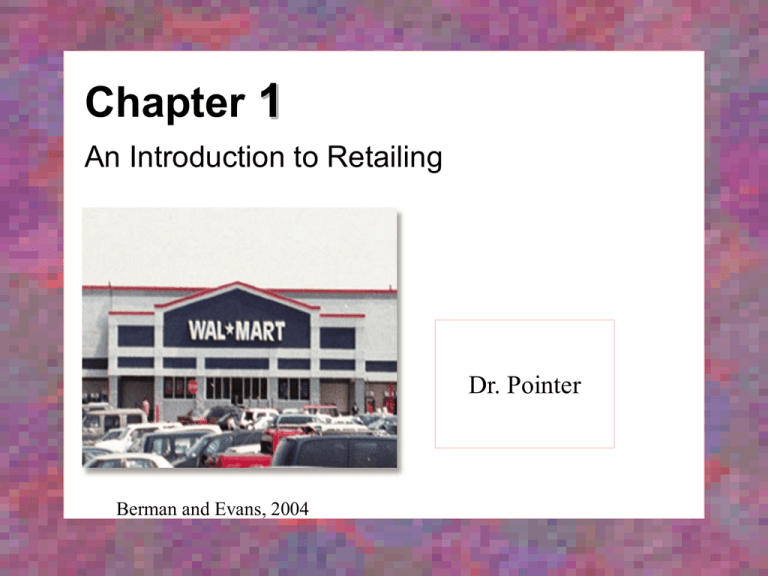
Chapter 1 An Introduction to Retailing Dr. Pointer Berman and Evans, 2004 Chapter Objectives To define retailing, consider it from different perspectives, demonstrate its impact, and note its special characteristics To introduce the concept of strategic planning and apply it To show why the retailing concept is the foundation of a successful business, with an emphasis on the total retail experience, customer service, and relationship retailing To indicate the focus and format of the text 1-2 Retailing Retailing encompasses the business activities involved in selling goods and services to consumers for their personal, family, or household use. It includes every sale to the final consumer. 1-3 Retailing Points • Retailing means selling both tangible and non- tangible products such services • All retailing activities are not done within a physical location, i.e. web, telephone 1-4 Issues in Retailing How can we best serve our customers while earning a fair profit? How can we stand out in a highly competitive environment where consumers have too many choices? How can we grow our business, while retaining a core of loyal customers? 1-5 Marketing Concept and Retailing • Marketing Concept defined is a philosophy to satisfy customers need and make a profit • Retailers practice the marketing concept 1-6 The Philosophy Retailers can best address these questions by fully understanding and applying the basic principles of retailing, as well as the elements in a well-structured, systematic, and focused retail strategy. 1-7 Reasons for Studying Retailing • Retailing has major impact in the Economy • Retailing is the final stage in delivering products to consumers 1-8 Impact of Retailing in Economy • Major part of commerce • Retailing trends often mirror trends in the economy • Annual U.S. Retail Store sales $3.5 Trillion Represents 31% of the total us economy • Retailing is a major source of job 23 million people employed in retailing 1-9 Figure 1.2 Career Pathways to Success 1-10 Career Pathways to Success 1-11 An Ideal Candidate for Retailing Career Be a people person Be flexible Be decisive Have analytical skills Have stamina 1-12 Table 1.1 The 10 Largest Retailers in the U.S., 2001 Rank Company $ Sales # of stores # of employees 1 Wal-Mart 219,812 4,414 1,383,000 2 Home Depot 53,553 1,348 256,300 3 Kroger 50,098 3,534 288,000 4 Sears 41,078 2,960 310,000 5 Target 39,362 1,381 223,500 6 Albertson’s 37,931 2,400 220,000 7 Kmart 37,028 2,150 240,525 8 Costco 34,797 369 64,500 9 Safeway 34,301 1,773 193,000 10 J.C. Penney 32,004 3,770 270,000 1-13 (million) Figure 1.3 The High Costs and Low Profits of Retailing 72.65 % - Manufacturer’s costs and profits 23.94 1-14 - Retailer’s operating, personnel and other overhead 1.33 - Taxes 2.08 - Profits Final Stage of Delivering Products • Retailers make the final contact with the consumers • Retailers are sandwich between consumers and channel members above them (manufacturers and wholesalers) • Retailers are a major source of information • Retailers provide sorting functions which results in greater variety for consumers 1-15 Figure 1.4 A Typical Channel of Distribution Manufacturer Retailer Wholesaler 1-16 Final Consumer Figure 1.5 The Retailer’s Role in the Sorting Process 1-17 Multi-Channel Retailing A retailer sells to consumers through multiple retail formats Web sites Physical stores 1-18 Relationship Management Among Retailers and Suppliers • Disagreements may occur: control over channel profit allocation number of competing retailers product displays promotional support payment terms operating flexibility 1-19 Distribution Types • Exclusive: suppliers make agreements with one or few retailers that designate the latter as the only ones in a specified geographic area to carry certain brands or products • Intensive: suppliers sell through as many retailers as possible • Selective: suppliers sell through a moderate number of retailers 1-20 Figure 1.7 Comparing Distribution Types 1-21 Special Characteristics of Retailing • Average transaction is much smaller than for manufacturers on average less than a $100.00 for department and specialty stores, and supermarkets. Costs must be tightly controlled • Consumers make many unplanned/impulse purchases • Consumers still make most purchases thru a location based store 1-22 Figure 1.8 Special Characteristics Affecting Retailers Small Average Sale Impulse Purchase Retailer’s Strategy Popularity of Stores 1-23 Retail Strategy An overall plan for guiding a retail firm Influences the firm’s business activities Influences firm’s response to market forces 1-24 Six Steps in Strategic Planning 1. 2. 3. 4. 5. 6. 1-25 Define the type of business Set long-run and short-run objectives Determine the customer market Devise an overall, long-run plan Implement an integrated strategy Evaluate and correct Aspects of Target’s Strategy Growth-oriented objectives Appeal to a prime market Distinctive company image Focus Strong customer service 1-26 Multiple points of contact Employee relations Innovation Commitment to technology Community involvement Constantly monitoring performance Figure 1.10 Applying the Retail Concept Customer Orientation Coordinated Effort Value driven Goal Orientation 1-27 Retailing Concept Retail Strategy Retail Concept • Customer Orientation –determine attributes and needs of customers • Coordinated Effort – integration of plans and activities to maximize efficiency • Value-driven – prices appropriate for the level of products and customer service • Goal orientation – sets goals for strategy There is a need to communicate with shoppers and view their needs as important 1-28 Practicing Retailing Concept Means • Concern for Total Retail Experience • Great Customer Service • Building Strong, lasting Relationships (Relationship Retailing 1-29 Customer Service • Activities undertaken by a retailer in conjunction with the basic goods and services it sells. Store hours Parking Shopper-friendliness Credit acceptance Salespeople 1-30 Relationship Retailing • Seek to establish and maintain long-term bonds with customers, rather than act as if each sales transaction is a completely new encounter – Concentrate on the total retail experience – Monitor satisfaction – Stay in touch with customers 1-31 Figure 1.12 A Customer Respect Checklist Do we trust our customers? Do we stand behind what we sell? Is keeping commitments to customers important to our company? Do we value customer time? Do we communicate with customers respectfully? Do we treat all customers with respect? Do we thank customers for their business? Do we respect employees? 1-32 Effective Relationship Retailing • Use a win-win approach – It is harder to get new customers than to keep existing ones happy • Develop a customer database – Ongoing customer contact is improved with information on people’s attributes and shopping behavior 1-33 Approaches to the Study of Retailing Institutional Functional Strategic 1-34 Parts of Retail Management: A Strategic Approach Building relationships and strategic planning Retailing institutions Consumer behavior and information gathering Elements of retailing strategy Integrating, analyzing, and improving retail strategy 1-35
